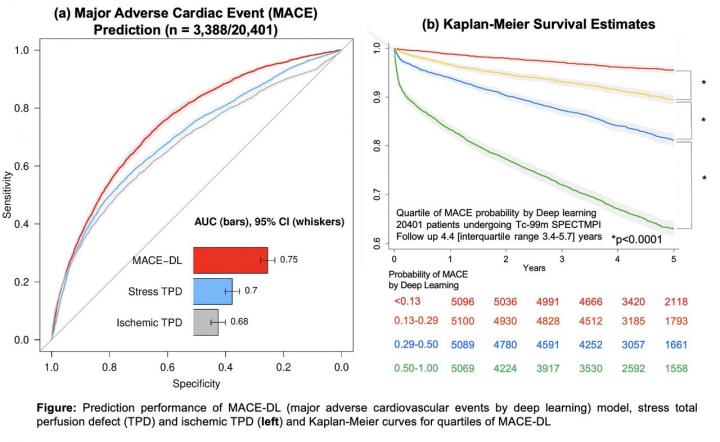SPECT + Deep Learning = Accurate Major Cardiac Event Prediction
Using advanced artificial intelligence can give patients a personalized assessment of their risk for significant events, such as heart attack or death.
Deep learning does a better job in predicting which patients will experience major adverse cardiac events than the current standard imaging protocols used to make these determinations, according to new research.
In a poster presented during the Society of Nuclear Medicine and Molecular Imaging 2021 Annual Meeting, researchers from Cedars-Sinai Medical Center in Los Angeles created a novel deep learning algorithm that can give patients a personalized assessment of their annualized risk for these types of events, such as heart attack of death.
For more SNMMI 2021 Annual Meeting coverage, click here.
“These findings show that artificial intelligence could be incorporated in standard clinical workstations to assist physicians in accurate and fast risk assessment of patients undergoing SPECT MPI scans,” said Ananya Singh, MS, a research software engineer in the Slomka Lab at Cedars-Sinai. “This work signifies the potential advantage of incorporating artificial intelligence techniques in standard imaging protocols to assist readers with risk stratification.”
Prediction performance of DL compared to quantitative measures and Kaplan-Meier curves for quartiles of DL.
Credit: Image created by Singh et al., Cedars-Sinai Medical Center, Los Angeles, CA.

To build their deep learning network, the team pulled data from 20,401 patients included in the largest available multi-center SPECT dataset – REgistry of Fast myocardial perfusion Imaging in NExt generation SPECT (REFINE SPECT). All patients had undergone SPECT MPI. The team used their network to score each patient on their individual likelihood to have a major adverse cardiac event during the average follow-up period of 4.7 years.
According to their analysis, the network was able to pinpoint the areas of the heart that were associated with an elevated risk of these events and return a risk score in less than 1 second. They determined that the patients with the highest deep learning scores had a 9.7-percent annual major cardiac event rate – a 10.2-fold increased risk over patients with the lowest scores.
For more coverage based on industry expert insights and research, subscribe to the Diagnostic Imaging e-Newsletter here.
What is the Best Use of AI in CT Lung Cancer Screening?
April 18th 2025In comparison to radiologist assessment, the use of AI to pre-screen patients with low-dose CT lung cancer screening provided a 12 percent reduction in mean interpretation time with a slight increase in specificity and a slight decrease in the recall rate, according to new research.
The Reading Room: Racial and Ethnic Minorities, Cancer Screenings, and COVID-19
November 3rd 2020In this podcast episode, Dr. Shalom Kalnicki, from Montefiore and Albert Einstein College of Medicine, discusses the disparities minority patients face with cancer screenings and what can be done to increase access during the pandemic.
Can CT-Based AI Radiomics Enhance Prediction of Recurrence-Free Survival for Non-Metastatic ccRCC?
April 14th 2025In comparison to a model based on clinicopathological risk factors, a CT radiomics-based machine learning model offered greater than a 10 percent higher AUC for predicting five-year recurrence-free survival in patients with non-metastatic clear cell renal cell carcinoma (ccRCC).
Could Lymph Node Distribution Patterns on CT Improve Staging for Colon Cancer?
April 11th 2025For patients with microsatellite instability-high colon cancer, distribution-based clinical lymph node staging (dCN) with computed tomography (CT) offered nearly double the accuracy rate of clinical lymph node staging in a recent study.